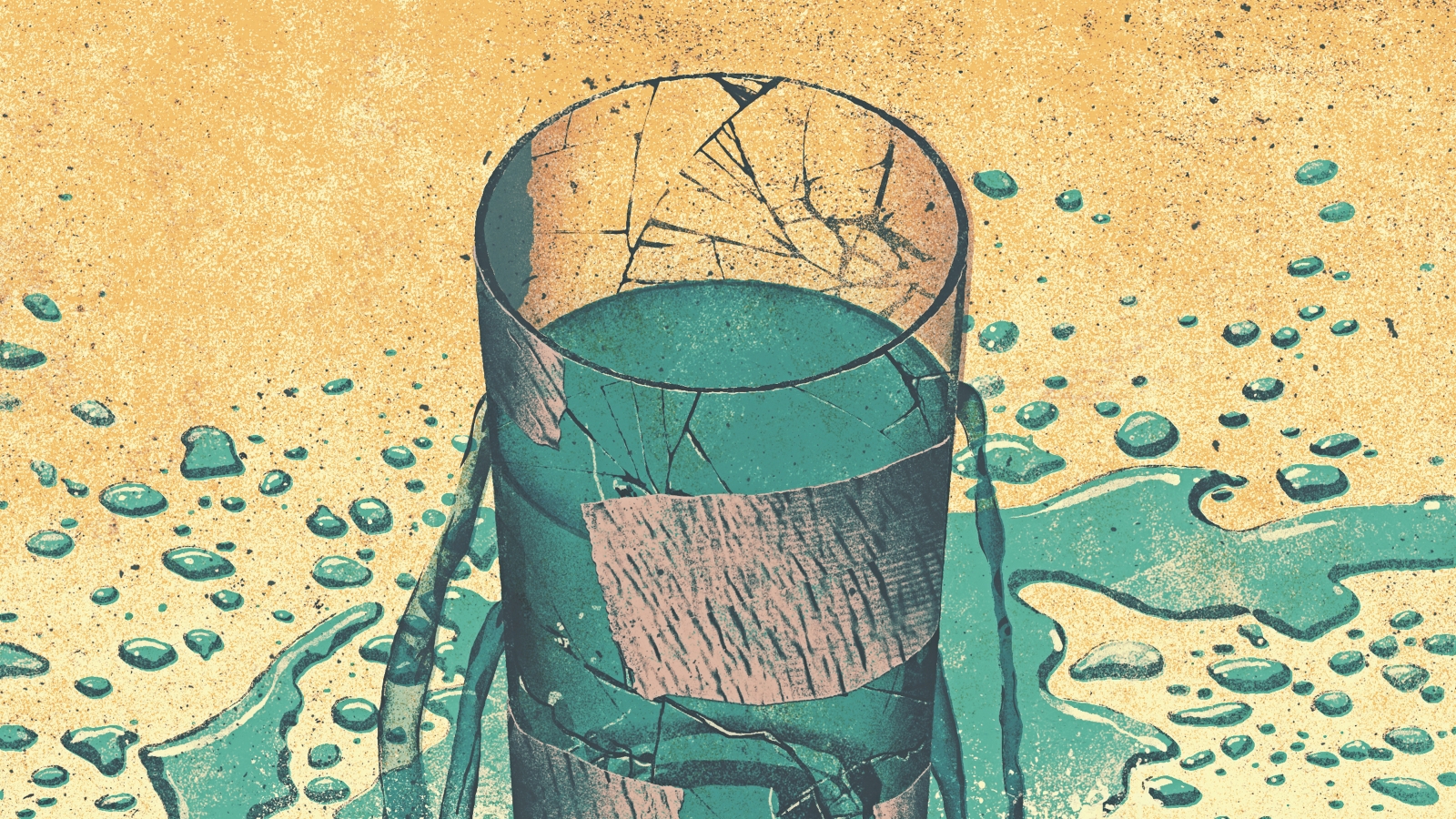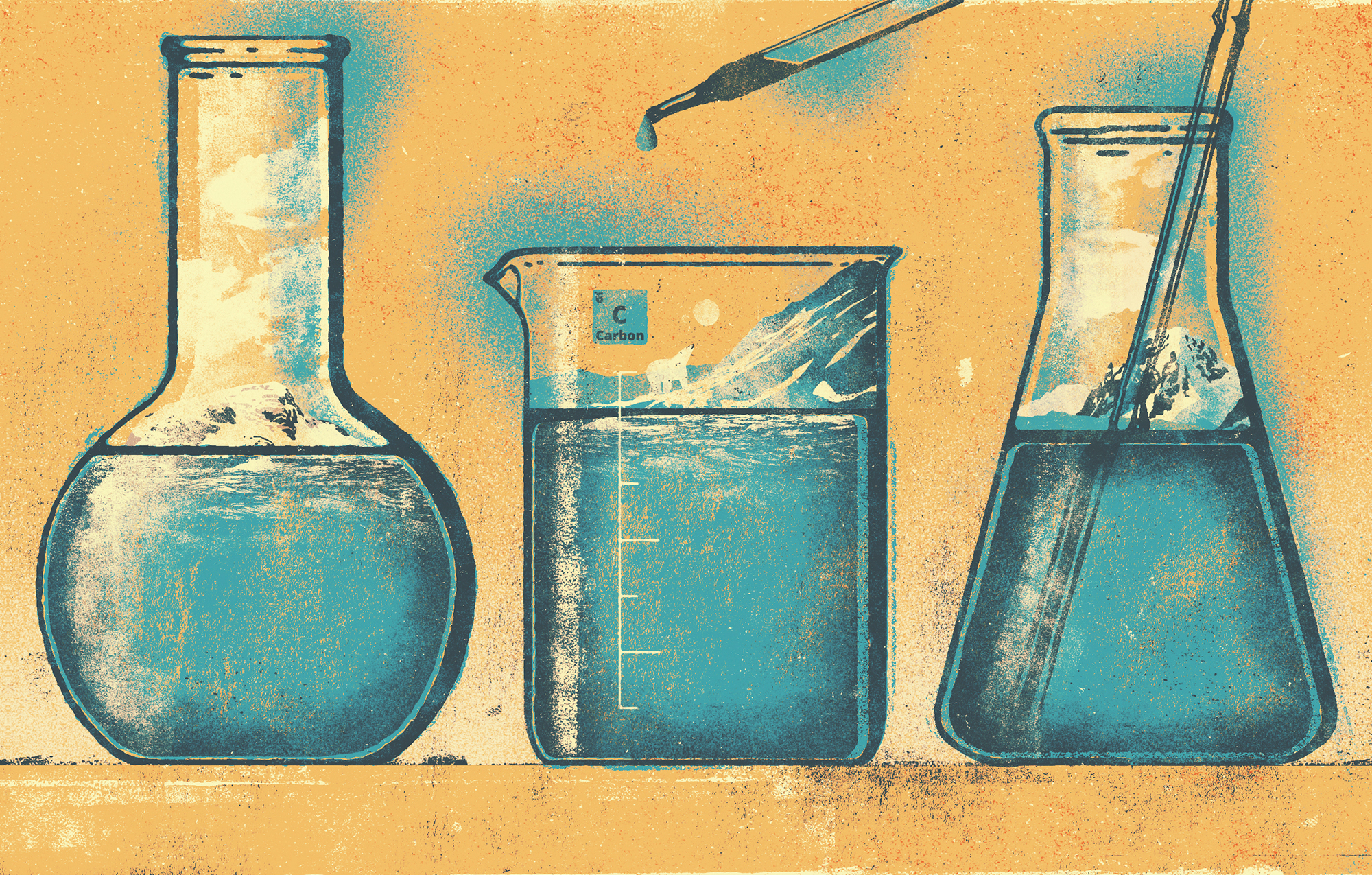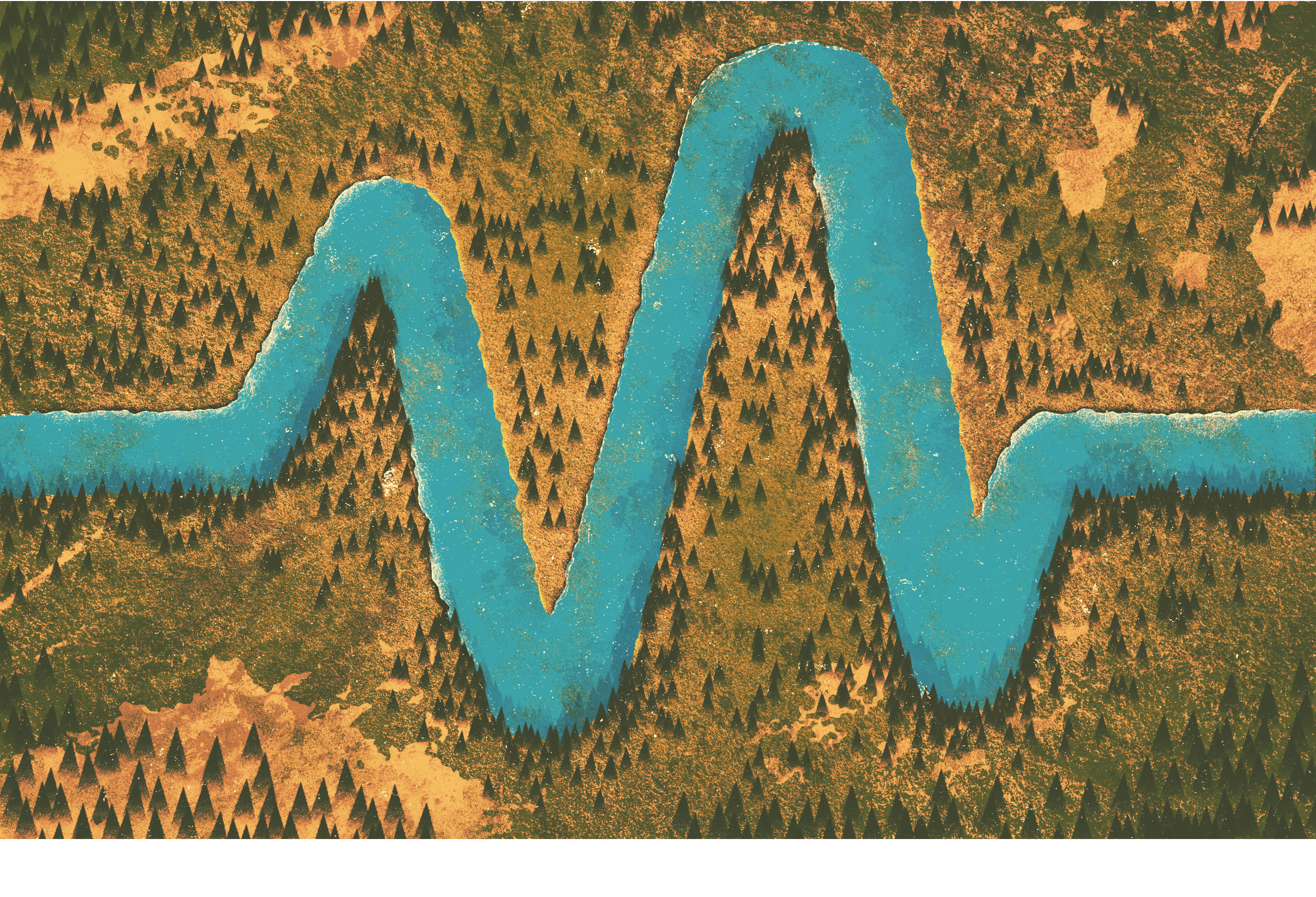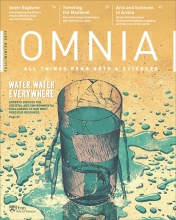Water, Water Everywhere
Arts and Sciences faculty study how this key resource is changing—from warmer oceans to once-thriving waterways now inhospitable to life—and what that means for the world.

In late summer 2017, Hurricanes Harvey and Irma barreled down on Texas and Florida, bringing with them unprecedented rain and floodwaters, while monsoons devastated regions across south Asia. Just one year prior, in that same part of the world, in the tiny Himalayan country of Bhutan, aquatic insects started disappearing from the streams and rivers that are their natural habitats, and some 10,000 miles to the southwest, São Paulo, Brazil, teetered on the edge of extreme water rationing— two days with, five days without—due to a devastating drought.
Closer to home, in Rust Belt cities— Detroit and Toledo, Pittsburgh and Syracuse—town hall meetings and questions to public officials brought tough-to-swallow answers about aging infrastructure and drinking water. And on the banks of the Schuylkill River, a collaboration between college undergrads, artists, and a German professor attempted to view the watery landscape from a new perspective.
In the U.S., water has been top of mind since “Flint” became synonymous with unsafe drinking taps three years ago. According to the World Health Organization, it’s been a problem for a much greater swath of people for even longer, and it’s one that will continue to swell as fully half the world’s population is expected to live in water-stressed areas by 2025.
Researchers and academics from the Penn Arts and Sciences are throwing their expertise behind everything from climate models in the Southern Ocean to infrastructure in Mumbai, in the hopes of adding to the collective body of knowledge in a way that slows the rush of water-related challenges to more of a trickle. It’s a daunting task.
“The minute you get into water and press in any direction, you find a huge amount of complexity around political systems, economic systems, social systems, cultural systems,” says Daniel Aldana Cohen, an assistant professor of sociology. “You have to be focused on the fundamentally social systems. Otherwise you’re going to miss the point.”
Water has become the universal connector, adds Howard Neukrug, a professor of practice in earth and environmental science. “While we re-build our aging urban water systems, we must work together to ensure an integrative, sustainable, and resilient approach that includes the needs and priorities of our cities and citizens. It is not just about floods and water scarcity; it is equally about environmental justice, social equity, and other critical quality-of-life issues.” These water-related facets will help shape how our planet persists in the coming century—and beyond.
The Planet’s Most Mysterious Ocean
Understanding what this means from a climatological perspective falls squarely into the realm of Irina Marinov’s research. An assistant professor of earth and environmental science, Marinov spends her days running complex climate models and poring over oceanographic data produced by satellites.
But even that is putting it simply.
Marinov studies the physics, chemistry, and ecology of the oceans in a climate-changing world. “The importance of what we do is in the future of humanity,” she explains. “We’re sure that New York City and the U.S. will find a way to survive the next 10 years or the next 100 years. But it’s really the long-term state of the world that we’re getting at.”
Much of the world’s environmental future hinges on heat and carbon: How much of these we generate, how much the oceans store, and whether these waters become more or less efficient at doing so.
Marinov’s classroom is the Southern Ocean, the vast water surrounding the Antarctic continent, which, because of its circulation characteristics, takes up more than half of the human-generated carbon and even more of our heat. Her reading material is the latest U.N. Intergovernmental Panel on Climate Change report; her special interest is the “biology embedded in the water.” The photosynthetic activity of phytoplankton is the base of the marine food web; it also results in CO2 uptake from the atmosphere.
“With climate change, we’re going to have less mixing between the surface and sub-surface waters,” she explains. This means that less oxygen can penetrate in the low-latitude oceans from the atmosphere into the sub-surface ocean, creating oxygen-deprived areas nefarious to fish and other organisms. Additionally, “since most nutrients in the ocean reside in the deep ocean, this will result in fewer nutrients brought to the surface,” she adds. “Plants photosynthesizing less. Less biological productivity in the low- to mid-latitudes. This is bad because less productivity means less CO2 uptake.”
There’s more to the story, however, with scientists seeing an interesting and opposite reaction in high latitudes. As the polar sea ice melts, more light is reaching plankton below the surface—some of which have rarely seen any light, ever. This results in more photosynthesis and greater CO2 uptake.
“It’s not clear yet who is going to win the CO2 game,” Marinov says. “Is it the high latitudes or the low latitudes?”
To date, we don’t have a great deal of data about those high latitudes, because of their geographic remoteness, extreme weather, and lack of observing platforms. Satellites can generate global maps of phytoplankton particle numbers and concentration, but penetrate no farther than 100 meters deep and cannot break through clouds. To learn more, a multi-institution project called the Southern Ocean Carbon and Climate Observations and Modeling, of which Marinov is a part, is in the process of releasing 200 deep-diving Argo floats equipped with physical, biological, and chemical sensors that will send back data daily.
It’s all in the name of measuring our planet’s most mysterious ocean. “We know very little about the Southern Ocean, a region critically important for global climate,” she says. A few minutes later, she returns to this point, then broadens it. “The oceans are all fundamental for climate. They are involved intimately in the global heat and carbon cycles on our planet. Without them, we would be warming much, much faster, and life as we know it would not be possible.”
Much of the world’s environmental future hinges on heat and carbon: How much of these we generate, how much the oceans store, and whether these waters become more or less efficient at doing so.
A Missing Connector
Places across the globe already feel some water-related changes—and are bracing for more. “There are really two main challenges cities face that have to do with water and climate change,” says Daniel Aldana Cohen, an assistant professor of sociology. “One is too much water, basically in the form of sea-level rise. The other is water stress.”
Cohen focuses more on the latter, specifically in Brazil’s largest city, São Paulo, and in the Bolivian city of Cochabamba. Nikhil Anand, an assistant professor of anthropology, and Bryan Currinder, G’17, of the environmental studies program, look at water stress in India, and Bhutan and Bangladesh, respectively. Despite varied backgrounds, all three study water as it pertains to infrastructure, growth, and social issues.
Mumbai is a fascinating example, says Anand, who wrote his book Hydraulic City about the 21-million-person metropolis. “There is a tendency to see water problems in Mumbai as a problem of lacks. Maybe Mumbai doesn’t have enough money to extend water to all its population. Maybe it doesn’t have enough technical expertise. Maybe it doesn’t have enough water.”
In actuality, it has all three, Anand says. Rather, the problem lies in an entirely different missing connector: land tenure. Until two years ago, a law existed that restricted water access to citizens who did not live in government-recognized housing, forcing them to obtain their water via political connections or social links. The courts recently struck it down, but many who previously struggled haven’t yet reaped the benefits of the new decision.
There’s also an interesting political dynamic at play. Anand spent from July 2007 until December 2008 in India, and has returned each year since. While there, he worked with residents, city engineers, and various intermediaries such as city councilors. He concluded that in Mumbai, water infrastructures aren’t centrally controlled top-down; rather, enhanced individual components—plumbers whose familiarity with a neighborhood exceeds what engineers know, for instance— exercise significant control over the water network.
“That diffused control was a source of great concern for the city, but it was a source of life for the people who could make claims on plumbers and politicians,” Anand says. “The city works precisely because it runs in ways it’s not supposed to.”
A City’s Worst-ever Drought
In São Paulo, a city equal in size to Mumbai, Daniel Aldana Cohen, an assistant professor of sociology, noticed a variation in the politics of water. Water distribution there tends to go hand in hand with unequal distribution of infrastructure and land access, something put into stark relief by a two-year drought that started in 2014. “It was a huge crisis,” he says. “There was less water available than had ever been the case in the history of the reservoir system.”
The São Paulo government wouldn’t consider rationing water. Instead, it mandated the city reduce pump pressure at certain times of day to cut overall usage. Valid in theory, this plan didn’t account for discrepancies in distribution of this resource. Wealthier citizens tend to live at lower elevations, in homes with attached water tanks; poorer citizens, whose neighborhoods often sit higher up, do not. A change to water flow left richer folks relatively unaffected, but unintentionally forced those less fortunate to go days without.
“Even within a single, relatively integrated urban system, where normally everybody has access, your place in the infrastructure really determines whether or not you end up getting water,” Cohen says. “Inequality plays a huge role, not just in terms of your wages, but also in terms of where you live, your house, which is a little less fungible. You can go out and work two shifts and still not have water. You live where you live.”
“Even within a single, relatively integrated urban system, where normally everybody has access, your place in the infrastructure really determines whether or not you end up getting water.” - Daniel Aldana Cohen, Assistant Professor of Sociology
São Paulo got lucky. The rains came and the drought subsided. But as of yet, the city hasn’t overhauled its infrastructure; coupled with new challenges compounded by climate change, a similar situation related to water stress will likely arise again—in São Paulo and in other cities around the world.
What the Flies Reveal
Part of the infrastructure challenge has to do with numbers. The U.N. projects that by 2030, the share of people residing in cities will tick upward in every single region. In just two decades, São Paulo grew 30 percent, hitting 21.3 million people in 2016. In Bangladesh and Bhutan, where Bryan Currinder, G’17, spent the better part of summer 2016, such growth—by more than 50 percent in all of Bhutan, more than 100 percent in some parts of Bangladesh—is already putting pressure on the waterways.
“Land use in both countries is having a heavy effect on the water quality of streams and rivers,” says Currinder, now a freshwater ecologist in California’s Sierra Nevada. “This is the trend the world over, but you need empirical evidence to confirm it.”
So Currinder turned to the bugs, namely mayflies, stoneflies, and caddisflies, called EPT insects for their Latin names Ephemeroptera, Plecoptera, and Trichoptera. “In most streams across the world, if you’re not finding the EPT insects, something has typically gone awry,” he says. “It’s kind of remarkable how you can extrapolate that those three groups should be present in healthy stream and river habitats, almost no matter where you are on the planet.”
He and Naimul Islam, LPS’17, an environmental studies classmate, in conjunction with the Stroud Water Research Center, created a two-pronged research project to learn more. Part one was technical: For as many streams and rivers as possible, collect and quantify macro-invertebrates from a single square meter of water, then use that number to calculate total bug density, as well as to note insect diversity.
Part two involved community engagement. “The citizen science aspect of the project uses leaf packs,” Currinder says, onion bags filled with leaf litter secured to stream bottoms. “After three to four weeks, you come back and that leaf pack should have been colonized by a pretty wide diversity of bugs. That’s a low-tech, low-cost technique that can give you a pretty good idea of water quality.”
In the end, the research team developed a baseline for the ecology of freshwater in the region. But importantly, they also gained an understanding of what’s changing these waterways, and in turn, how that affects the people close by.
Art and Life on the Schuylkill
In painting a picture of how a body of water touches those who live around and near it, Associate Professor of Germanic Languages and Literatures Bethany Wiggin’s work on the Schuylkill River does something similar to the research of Bryan Currinder, G’17, though it seems farther afield for Wiggin. That is, until you dig into her Penn tenure.
In 2013, Wiggin first taught a class about utopian experiments that incorporated conversations with students about their vision for a sustainable future. Several of those students then completed a year-long independent study with Wiggin that culminated in $10,000 in grants for undergraduates from Facilities and Real Estate Services’ Green Campus Partnership. “The winners of those fellowships, they had individual research projects, but the way they thought their work overlapped was place-based education,” Wiggin says. The Schuylkill became the great link; the collaboration, the genesis of the Penn Program in Environmental Humanities (PPEH).
Now, after a three-year pilot that included symposiums and public-engagement projects and an installation on the river in conjunction with an artist in residence, PPEH has solidified its place at the University, with Wiggin at the helm. A $1.5 million grant from the Andrew W. Mellon Foundation covers four years of future work to enhance environmental humanities at Penn and in the broader Philadelphia region.
It all began with some questions about how the Schuylkill has evolved. “It wasn’t just a historian who could explain it. It wasn’t just a river ecologist or a civil engineer. We needed all of those people to shine light on what was happening,” Wiggin says. “It was in that moment that I applied for the Whiting grant.”
As a 2016–17 Whiting Public Engagement Fellow, Wiggin worked with schoolchildren and scientists, academics and community members to understand and better their relationship with the Schuylkill, which today provides water to more than 1.5 million people. Wiggin also used the grant as an impetus for a competition asking for “eco-topian tools” that would make the river cleaner and more habitable. Winners included a giant charcoal filter (in the same vein as the Brita), bio-pod floating habitats, and an illustrated guide to native water plants.
“This is such a complex landscape that we need to foster interdisciplinary research,” Wiggin says. “People really understand in this time of these massive challenges… it’s going to take a different type of research community. The engineers alone are not going to be able to fix this.” That’s precisely what Howard Neukrug, Professor of Practice in Earth and Environmental Science, is banking on.
A Holistic Approach
Of all the researchers and academics profiled in this piece, Howard Neukrug, Professor of Practice in Earth and Environmental Science, has the most years of serious water experience under his belt. For nearly four decades, he worked in all aspects of the water utility business, most recently as CEO and Commissioner of Philadelphia Water. In his “retirement,” he joined Penn as a professor in earth and environmental science and as a Penn Institute for Urban Research faculty fellow. He teaches two classes, one about the role of water in urban sustainability and resilience, the other about the water industry in the 21st century.
Beyond that, Neukrug has two pet projects. The first aims to prevent another Flint in other post-industrial cities with declining populations across the Rust Belt, spots like Detroit and Syracuse and Toledo. “What we’ve found is that the challenges affecting our utilities, communities, and cities are increasingly intersectional,” he says, “and the issues our water systems, environments, and people face are often intertwined.”
He notes as an example concern over lead pipes and exposure in children. “The solution is much more holistic than just digging up old pipes,” he explains. “We need to better understand lead levels in children over time, routes of exposure from air, soil, dust, and water, and then mount a full-fledged effort to eradicate the greatest sources.” This will require funding from a multitude of places, including government entities like Housing and Urban Development and the Centers for Disease Control and Prevention, the water utilities, and the paint industry.
“We need to better understand lead levels in children over time, routes of exposure from air, soil, dust and water, and then mount a full-fledged effort to eradicate the greatest sources. – Howard Neukrug, Professor of Practice in Earth and Environmental Science
It’s all part of establishing a sound water-management system for our cities, inclusive of sustainable improvements in areas like road infrastructure, education, jobs, and public safety. “Flint is a reminder of the absolute critical need for this, irrespective of cost,” Neukrug says. “With water, we thrive. Without it, we will surely perish.”
That’s when Neukrug brings up his second project: creating a water center at the University of Pennsylvania. If Neukrug had his druthers, this center would make Penn the go-to hub on the eastern seaboard for all things water-related, a think tank focused on issues of global relevance that helps prioritize practical applications of technologies and other instruments in this realm.
He doesn’t picture an actual physical center but more an intellectual meeting of the minds, inclusive of all schools at Penn. “I see the water center as a way to take a diverse set of thought leaders and experts from all corners of the water practice and academia and give them a chance to talk, network, compare notes—and perhaps move us all a little closer to implementing the innovations that the world wants and deserves.”
The seeds of such a center have already started to germinate. Bethany Wiggin, Associate Professor of Germanic Languages and Literatures, and Nikhil Anand, Assistant Professor of Anthropology, are working together on one of the Penn Arts and Sciences Making a Difference in Diverse Communities grants, exploring the future of rivers and coastal cities through the lens of Philadelphia and Mumbai. Unquestionably, Penn’s research community is ripe for many more such partnerships—and they’ll be necessary to solve the water problems that climate change will inevitably bring, says Daniel Aldana Cohen, Assistant Professor of Sociology. “Water is just not getting as much attention as it should. We know that water will become increasingly scarce in big cities for the foreseeable future. So the question is, how is it going to be shared?”
Right now this all simmers under the surface, but soon it will come to a boil. And Penn researchers, on their own and together, will continue the trek to answer unanswered local, national and global questions about water.
Urban Defenses
When Hurricane Harvey dropped more than 50 inches of rain on Houston, the country’s fourth largest city, in August 2017, the metropolis and its surrounds went under water. By some accounts, more than 25 percent of the encompassing county flooded. In that same month in parts of South Asia, torrential monsoon rains caused flooding and landslides that affected tens of millions of people.
Similar scenarios play out across the U.S. and the world, but now such events— previously forecasted to happen once in a lifetime—come every few years. This type of deluge puts a new strain on urban centers, forcing them to rethink water-related disaster preparedness and infrastructure plans.
“Many cities were originally built close to good-quality drinking water supplies and near access to safe harbors for commerce and trade,” says Howard Neukrug, a professor of practice in the Department of Earth and Environmental Science. “With that proximity to large bodies of water, you may also encounter extreme storm events like what we’ve seen in Houston.”
Or what transpired with Hurricane Sandy in New York in 2012 or Hurricane Katrina in New Orleans in 2005. Also in 2005, the monsoon in Mumbai brought 37 inches of rain on a single July day.
Though every place has its idiosyncrasies, certain similarities—in Mumbai and Houston, for instance, the paving-over of absorbent terrain in favor of asphalt—play a part in the challenges that accompany excess water. “Your highways become rivers instead,” says Nikhil Anand, an assistant professor of anthropology. “We need to look at what we can do after the flood, as planners, as architects, as infrastructure specialists.”
To Neukrug, that means preparing for the unpredictable, making water systems as resilient as possible by building in redundancies. For example, Philadelphia, where he ran the water utility before joining Penn’s faculty, has three drinking water treatment plants. Should something catastrophic happen to one, two others provide full backup. Neukrug also mentions diversifying the water utility’s energy sources, including generating its own electricity, to keep the water pumps running no matter what.
“By decreasing the imperviousness of the city’s surfaces and increasing the sponge-like qualities of the grounds surfaces through green storm water infrastructure techniques, you can mitigate, if not eliminate, certain problems,” he says.
All that being said, even the best-prepared cities can only do so much. “When a Hurricane Harvey or a Hurricane Sandy hits, you go back to the basics to do your best to respond to events as they occur,” Neukrug says. “History has taught us, however, that nature always wins.”







